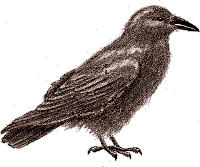Raaf
Categorieën
Archief
|
2013-05-02 18:01
Appearance is everything for a modern monarchy, so let me offer you to do to the royals what they are made for. Look at their fashion statements:
If you want to take the overview for yourselves first, you may look at this slide show:
http://springelkamp.nl/Foto/Inhuldiging/capture_002_01052013_201648.jpg.html?slide=1
First we have crown prince Filip and princess Mathilde of Belgium. The prince is wearing a military uniform, the most common costume for kings and princes. A sash is obligatory, bearing a prestiguous Grand Cross. Both Belgians wear the appropriate Grand Cross of the Order of Orange-Nassau on their orange sash with white and blue edge:
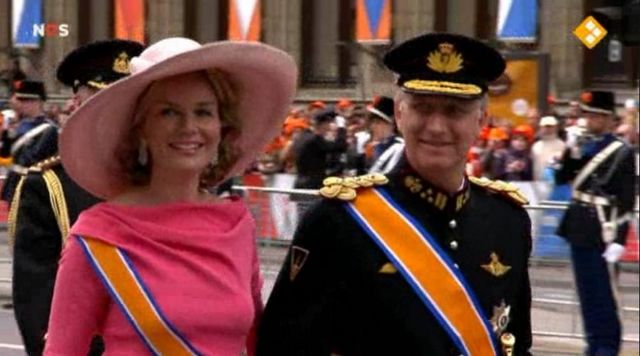
Quite similarly in style, albeit much more attractive than the thick Belgian guy, are Norwegian crown prince Haakon and princess Sophie: (by the way, there are generally only crown princes and no acting monarchs present, because during the inauguration King Willem Alexander must be the highest ranking person, obviously)
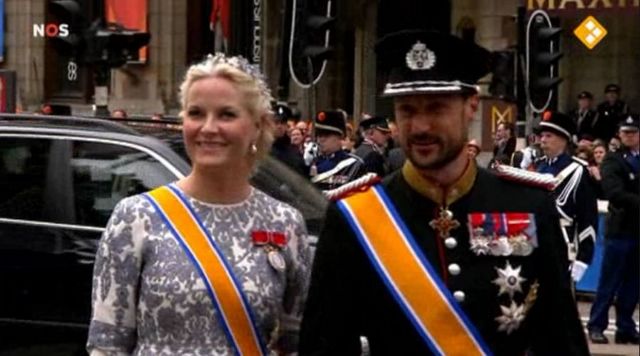
Next in line, Spain, with crown prince Felipe and the former TV presenter princess Letizia, who doesn't wear the Orange-Nassau sash, but rather a blue and white one, probably the Spanish Order of Charles III, as that ribbon is present in her coat of arms. Maybe the Dutch royals haven't had the opportunity to offer her their nice insignes, or she prefers the blue white colours on her dress.
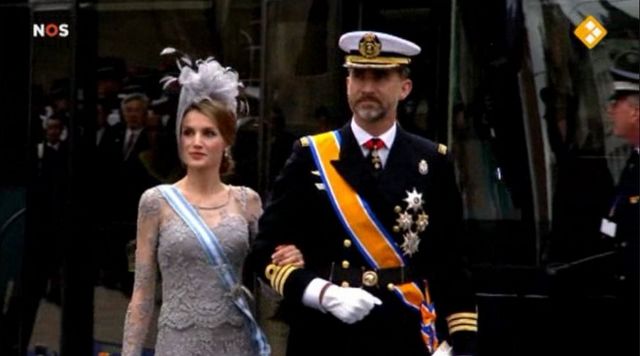
And Prince Guillaume, Hereditary Grand Duke of Luxembourg, and Hereditary Grand Duchess Stéphanie offer us the same kind of decorations, she probably wearing the Grand Cross of the Order of Adolphe of Nassau.
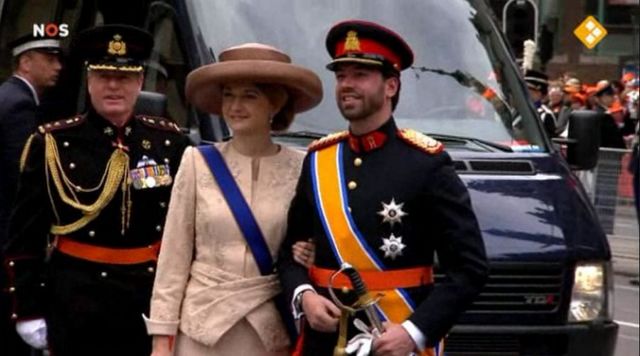
We now see the non-European crown prince Billah and princess Sarah of Brunei. They wear a different sash, the Grand Cross of the Order of the Crown, a House order of Orange. We will discover that she is the only woman wearing a headscarf.
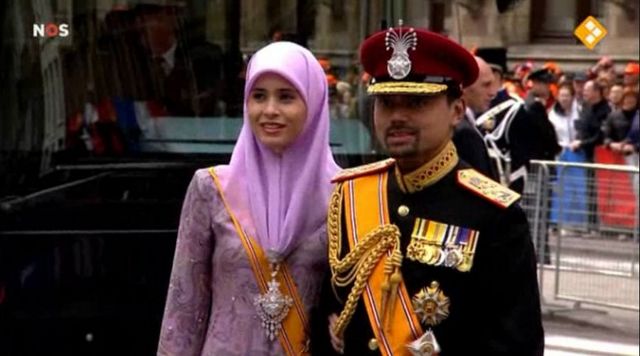
And here is a prince who has received that Grand Cross of the Order of the Crown already before the previous Dutch inauguration, crown prince Charles. Camilla probably hasn't entered the circle of friends of Orange yet, as she is wearing a Royal Victorian Order (my guess).
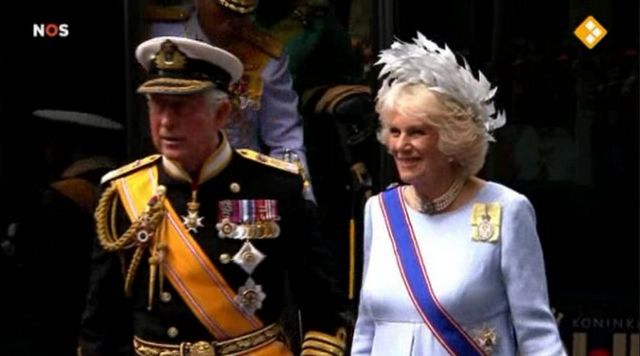
First prince in civil dress, now, Prince El Hassan bin Talal and princess Sarvath El Hassan of Jordan, both with the now familiar Order of Orange-Nassau.

The highest royal guests, crown prince Naruhito en princess Masako of Japan. He has a Order of the Crown, but she wears the Japanese Order of the Precious Crown, specially for female recipients. She must have chosen it for the appropriate colour!
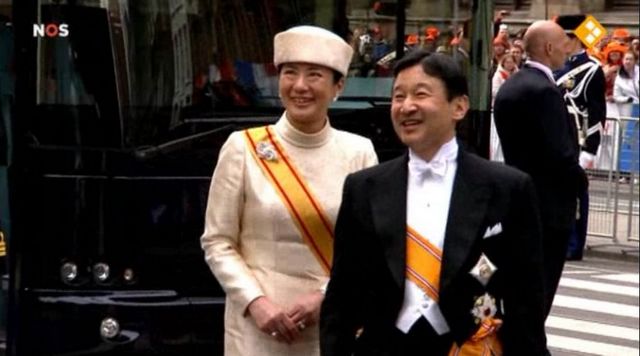
Crown prince Maha Vajiralongkorn and prinses Maha Chakri Sirindhorn of Thailand, they wear their own Order of the Royal House of Chakri.
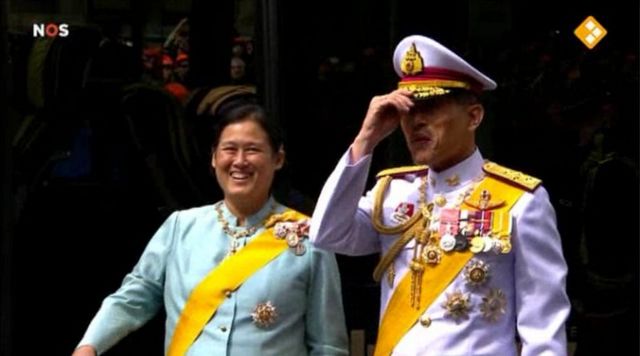
Heredery prince Alois en heredery princess Sophie of Liechtenstein. I couldn't identify their red sash, was hoping it would be a Golden Fleece, that uses a red sash, and, being founded by the Burgundy House, was partially inherited by the Austrian Hapsburgs, but a complete list of members doesn't mention them.
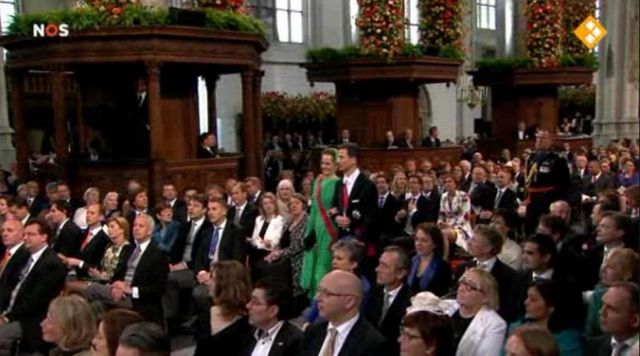
Crown prince Frederik of Denmark has a nice hat, and a nice princess Mary. They wear the light blue Order of the Elephant over their left shoulder.
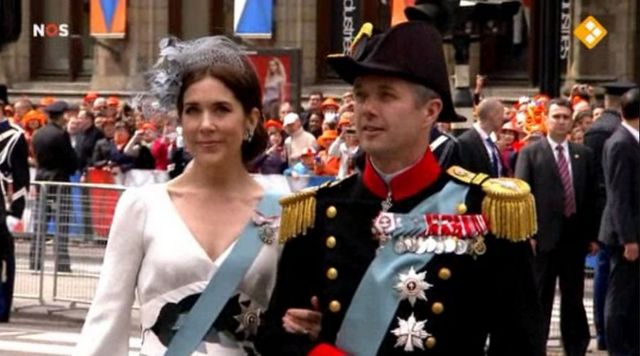
Swedish crown princess Victoria and prince Daniel have a similarly coloured Royal Order of the Seraphim over the right shoulder. And she has a nice hat.
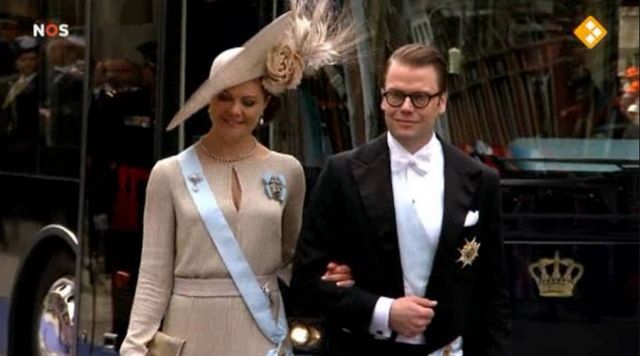
Now two unchaperoned unveiled muslim princesses, Sheikha Moza bint Nasser al Misned from Qatar
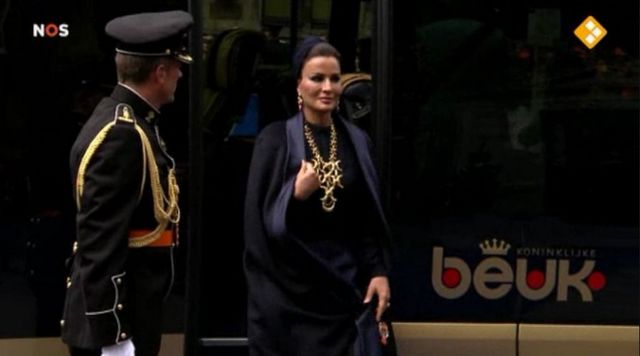
and prinses Lalla Salma of Morocco. They don't need a sash, do they?
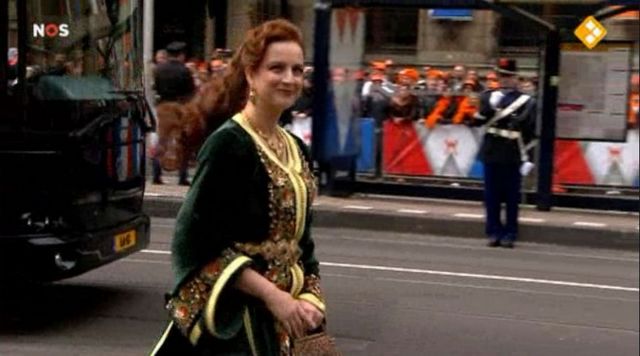
2013-05-03 9:41
Last Tuesday the Netherlands got a new king, from the House of Orange-Nassau.
So how come a Princedom in the Rhone valley and a Countship in Southern Germany become sovereigns in the Netherlands.
It all goes back to the richest man of Europe in the early 14th century, and an obscure one as well.
Willem van Duivenvoorde doesn't even have an English Wikipedia entry, was borne in 1290 as bastard of a nobleman in Holland.
He became a squire of the Count of Holland, and, being very bright, he rose to Chamberlain and Treasurer.
Willem's genius was in modern administration. He ran a large chancellery with clerics for himself who listed all his properties and he carefully analysed every opportunity for profit.
This allowed him to acquire a lot of property in the border area of the County of Holland and the Duchy of Brabant, where he also reclaimed a lot of land in a very efficient way.
Count and Duke both though he acquired these lands in lease from the other, while in reality he just took them for himself.
When the King of England started the 100 Years War against France, Willem lent him as much money as England could deliver wool to him. But when the King needed more money and offered his crown jewels, Willem refused.
Quite rightly so, because when the Florentine bankers accepted this offer, they were never repaid, and they went broke, effectively ending the power of the Florentine monetary power.
Willem had also very good relations with the Duke of Brabant, who knighted him in Brussels in 1328 and made him a Banneret, ending his bastard state, and enabling him to inherit his possessions to his relatives.
When he died he ruled over the city of Breda and large areas in the South of Holland and the North of Brabant, and he was the richest man of his time in Europe.
However, he died without legitimate children, so his brother son inherited his possessions, and through a marriage to the Count of Nassau in 1403.
This made the Counts of Nassau an important player in the internal affairs of Brabant and Holland, that had both come under the House of Burgundy.
So when William of Orange-Nassau inherited the sovereign title Prince of Orange, he was through his high title and large possessions in the Netherlands the most important local noble under Phillips II of Hapsburg, King of Spain and Sovereign of the 17 Burgundy Provinces. (Duke of Brabant, Gelre, Luxembourg, Limburg, Count of Holland, Zeeland, Artois, Hainaut, Namen, Zutphen, Lord of Groningen, Friesland, etc. etc.)
2013-06-11 16:57
In 1250 AD the weather was once again much too dry, and a contagious disease spread among the animals. Almost all the cattle in the Wolden[1] that had survived last year or that was bought to replace what had perished, died. And in the heat of the summer the corpses rotted and there was a terrible stench, that also made people ill. Like Galenus says, rotten air is even worse than rotten food.
In the Wolden a new kind of plague appeared among the people. A poisonous blister appeared between the skin and the flesh, in the beginning the size of an acorn. People thought it was some kind of sting from an insect, but those who studied it more thoroughly said that a few days before it appeared they had felt that the balance in their bodies had been disturbed. It seemed to travel all through the body looking for a way out, and very often it broke out in the neck, above the shoulders. If the blister was cut out on the first day, and the wound burnt with a hot iron, the person could recover. If not, one died in seven days. Without surgical treatment almost nobody survived.
[..about Galenus and Vergil on illness and rotten air ..]
We include this in case of a - hopefully not - similar pestilence in the future, that one may, especially in the summer, bury the corpses deep into the ground. [..]
In the same year Pope Innocentius returned from Lyon to Rome.
In the same year, while the Frisians were hit so hard, the Groningers seemed to mock them. Without mercy they raised the prices of the grain they imported by ship from other countries. But behold, they suffered a different peril. Because. Koenraad of Groningen, the knights Adolf and Rudolf of Peize and their following, as well as the majority of the citizens of Groningen, have done the Frisians injustice, and they disturbed the peace of the horse market - they confiscated the best horses of their choice for themselves. They even imprisoned nobles from Fivelgo, and caused a lot of damage and discomfort to people from Hunsingo. So then the people of Fivelgo and Hunsingo finally made peace, after twenty-two years of conflict over the island of the people of Uithuizen. It appeared as if God had arranged for the destruction of Groningen. The peace was brokered by Sicco, dean of Farnsum, an eloquent man skilled in worldly affairs, together with other wise men, both monks and laymen. Thus the fight that had kept on for so long and had cost so much blood was ended. It was ruled that one quarter of the island would go the those of Eenrum, who had tried to acquire half of it originally, and the other three quarters would go to those of Uithuizen.
For all those fallen in the war, the headmen of both parties paid weregild. The party of Fivelgo had killed about hundred men, the other party short by eighteen the same. The ransoms for the prisoners were returned, by the headmen, not by those who had received them. For the clearly by them committed plunder and arson those of Eenrum gave to those of Fivelgo and their headmen, namely those of Uithuizen, 24,000 mark in Fivelgo coinage.
Those of Uithuizen gave those of Hunsingo 900 mark. The plundering of cloths and weapons, and all inflicted wounds, except those of the six limbs, was forgiven, for God and the good of peace.
When the peace between them was made, but everything was not yet settled definitely, they flocked together as one people to attack Groningen. After they had conducted brave attacks, they destroyed the castle Gronenburg[6]. That castle was built specifically against the inhabitants of Drenterwolde, on the banks of the Hunze, and that same Hunze surrounded it almost completely; one considered the castle as a threat to many, especially the residents nearby. Next they laid siege to Groningen, but because of the wet autumn and the unstable air they didn't manage to take the city that year.
[1] Wolden: (lit. Woods) the (partly developed) peat areas between the coastal clay lands and the sandy high ground of the inland.
[2] Hunsingo: Frisian shire around the river Hunze, NW of Groningen
[3] Fivelgo: Frisian shire around the river Fivel, NE of Groningen
[4] Uithuizen: coastal village in Fivelgo
[5] Eenrum: coastal village in Hunsingo
[6] Castle of the Van Groningen family.
2013-06-11 17:04
In the year of our Lord 1251, immediately after Easter [Apr 16], those of Fivelgo and Hunzingo gave each other hostages and renewed their alliance; and with the help of those of Menterne[1] they laid siege to Groningen. Some crossed the ramparts, and climbed on ladders and started to fight them manfully. The Groningers defended themselves for a long time with stones and trebuchets, expecting that the Frisians would, according to their customs, soon return to their own region. But when the Frisians had maintained their siege for four weeks, the Groningers began to fear that, when the city would be taken by force, an enormous carnage would take place. Therefore they surrendered themselves in the hands of the enemy. The Frisians set the condition that the walls would be destroyed, and that the stonehouses would be pulled down till the storage rooms; the traders were allowed to keep living there with their possessions, but the knights would have to leave the city with their life and property, and would never be allowed again to have a residence there. And so the the walls were leveled for the largest part and the houses were lowered. The knights resided that year on the other side of Coevorden[2], where it was possible. Also the fortification of Peize was destroyed.
[1] Menterne: Frisian shire East of Fivelgo.
[2] Castle guarding the Southern moor pass of Drenthe
[3] Peize: village to the SW of Grongingen, where the Van Groningen clan had a castle.
|
